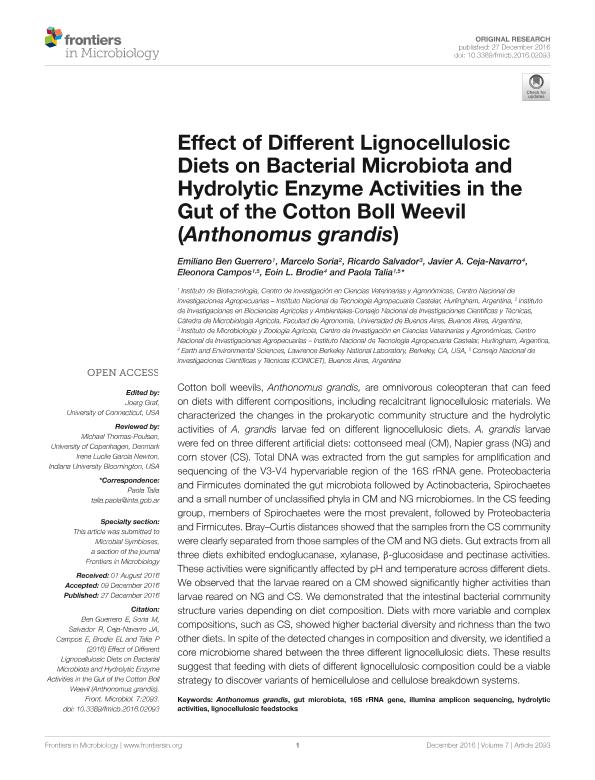Artículo
Effect of different lignocellulosic diets on bacterial microbiota and hydrolytic enzyme activities in the gut of the cotton boll weevil (Anthonomus grandis)
Ben Guerrero, Emiliano; Soria, Marcelo Abel; Salvador, Ricardo; Ceja Navarro, Javier A.; Campos, Eleonora ; Brodie, Eoin L.; Talia, Paola Monica
; Brodie, Eoin L.; Talia, Paola Monica
 ; Brodie, Eoin L.; Talia, Paola Monica
; Brodie, Eoin L.; Talia, Paola Monica
Fecha de publicación:
27/12/2016
Editorial:
Frontiers Media
Revista:
Frontiers in microbiology
ISSN:
1664-302X
e-ISSN:
1664-302X
Idioma:
Inglés
Tipo de recurso:
Artículo publicado
Clasificación temática:
Resumen
Cotton boll weevils, Anthonomus grandis, are omnivorous coleopteran that can feed on diets with different compositions, including recalcitrant lignocellulosic materials. We characterized the changes in the prokaryotic community structure and the hydrolytic activities of A. grandis larvae fed on different lignocellulosic diets. A. grandis larvae were fed on three different artificial diets: cottonseed meal (CM), Napier grass (NG) and corn stover (CS). Total DNA was extracted from the gut samples for amplification and sequencing of the V3-V4 hypervariable region of the 16S rRNA gene. Proteobacteria and Firmicutes dominated the gut microbiota followed by Actinobacteria, Spirochaetes and a small number of unclassified phyla in CM and NG microbiomes. In the CS feeding group, members of Spirochaetes were the most prevalent, followed by Proteobacteria and Firmicutes. Bray-Curtis distances showed that the samples from the CS community were clearly separated from those samples of the CM and NG diets. Gut extracts from all three diets exhibited endoglucanase, xylanase, ß-glucosidase and pectinase activities. These activities were significantly affected by pH and temperature across different diets. We observed that the larvae reared on a CM showed significantly higher activities than larvae reared on NG and CS. We demonstrated that the intestinal bacterial community structure varies depending on diet composition. Diets with more variable and complex compositions, such as CS, showed higher bacterial diversity and richness than the two other diets. In spite of the detected changes in composition and diversity, we identified a core microbiome shared between the three different lignocellulosic diets. These results suggest that feeding with diets of different lignocellulosic composition could be a viable strategy to discover variants of hemicellulose and cellulose breakdown systems.
Archivos asociados
Licencia
Identificadores
Colecciones
Articulos(SEDE CENTRAL)
Articulos de SEDE CENTRAL
Articulos de SEDE CENTRAL
Citación
Ben Guerrero, Emiliano; Soria, Marcelo Abel; Salvador, Ricardo; Ceja Navarro, Javier A.; Campos, Eleonora; et al.; Effect of different lignocellulosic diets on bacterial microbiota and hydrolytic enzyme activities in the gut of the cotton boll weevil (Anthonomus grandis); Frontiers Media; Frontiers in microbiology; 7; 2093; 27-12-2016; 1-13
Compartir
Altmétricas



